Google Maps has added the rocky planets, moons of the ice giants, the “
dwarf planet
” Pluto and the International Space Station. To access the menu for the other planets, users just have to zoom out from the Earth and select the satellite view. The maps were created by putting together multiple photographs, and the level of detail is not the same as maps of the Earth. There are also visible streaks on many of the maps and the search field disappears when you zoom out from the Earth, so there is no way to look for a particular location. However, clicking on any map entry reveals additional details about the feature, including the type, size and origin of the name. Mercury has a pretty clean map with minimum imaging artifacts. Users can see the shadows in the craters towards the North Pole of the innermost rocky planet, which scientists believe contain deposits
of ice
, despite its proximity to the Sun. The images forming the surface of Mercury are most likely to have been captured by Messenger, the only spacecraft to have orbited Mercury, which
crashed into the surface of the planet
on May 2015. [caption id=“attachment_4154977” align=“alignnone” width=“825”]
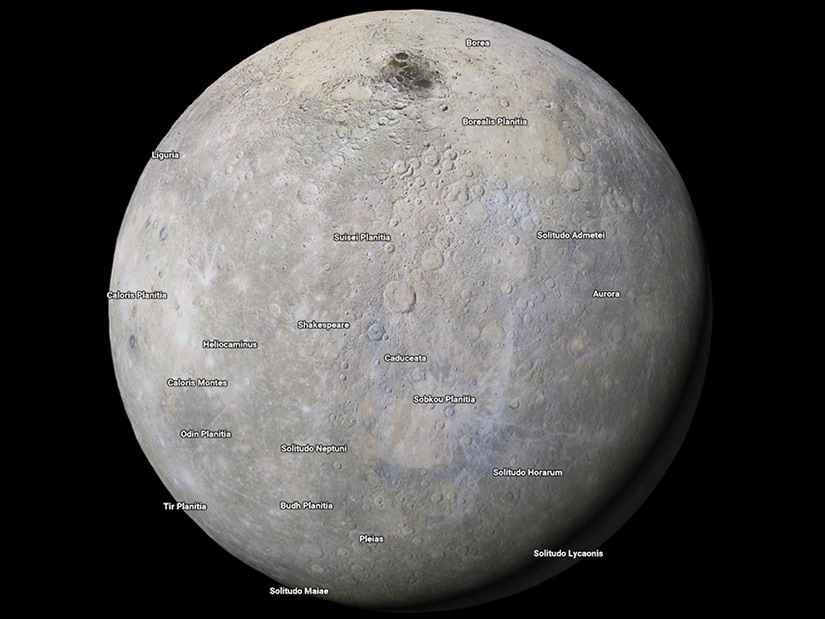 Mercury. Image: Google Maps.[/caption] The view starts with the night side of the planet, and as you zoom in, the shadows shift and the celestial body is revealed in the daylight. There is no way to actually look at the planet in the night side, which is a shame considering the interesting
cloud patterns in the night side of Venus
. The details on the surface get clearer as you zoom in.
ISRO
and NASA are both planning missions to Venus, and
NASA is even considering using a clockwork rover
to handle the extreme environment. There is no need to wait for these missions, as Google lets you go there right now. [caption id=“attachment_4154249” align=“alignnone” width=“825”]
Mercury. Image: Google Maps.[/caption] The view starts with the night side of the planet, and as you zoom in, the shadows shift and the celestial body is revealed in the daylight. There is no way to actually look at the planet in the night side, which is a shame considering the interesting
cloud patterns in the night side of Venus
. The details on the surface get clearer as you zoom in.
ISRO
and NASA are both planning missions to Venus, and
NASA is even considering using a clockwork rover
to handle the extreme environment. There is no need to wait for these missions, as Google lets you go there right now. [caption id=“attachment_4154249” align=“alignnone” width=“825”]
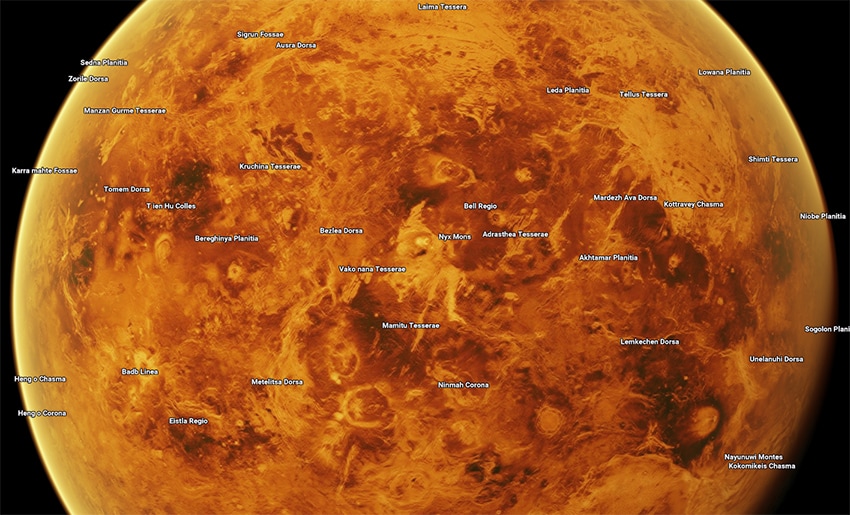 Venus. Image: Google Maps.[/caption] In July this year,
Google rolled out a Street View of the International Space Station
that allowed users to explore the interiors and check out the various modules. Users are plonked into the breathtaking view from the Cupola, an observation deck built by the European Space Agency. Users can get a sense of the cramped interiors and understand what moving with six degrees of freedom feels like in the low gravity environment of the space station. [caption id=“attachment_4154269” align=“alignnone” width=“825”]
Venus. Image: Google Maps.[/caption] In July this year,
Google rolled out a Street View of the International Space Station
that allowed users to explore the interiors and check out the various modules. Users are plonked into the breathtaking view from the Cupola, an observation deck built by the European Space Agency. Users can get a sense of the cramped interiors and understand what moving with six degrees of freedom feels like in the low gravity environment of the space station. [caption id=“attachment_4154269” align=“alignnone” width=“825”]
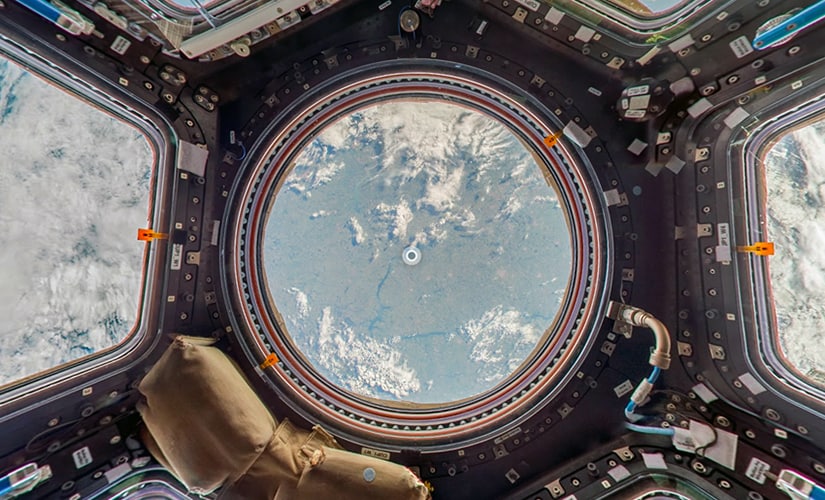 The Cupola of the ISS. Image: Google Maps.[/caption] Next up is perhaps the most exciting planet on the list, but the surface is full of streaks. A number of orbiters and probes have studied the Red Planet, with the most recent ones being NASA’s Odyssey,
Mars Reconnaissance Orbiter
and
Maven
. ESA’s Mars Express and ISRO’s
Mars Orbiter Mission
are also currently in orbit around the planet. Users can check out the locations of the breathtaking images captured by the Mars Orbiters, trace the
journey of Curiosity
across the Martian surface, or check out the locations catalogued by
ISRO’s Mars Atlas
. [caption id=“attachment_4154289” align=“alignnone” width=“825”]
The Cupola of the ISS. Image: Google Maps.[/caption] Next up is perhaps the most exciting planet on the list, but the surface is full of streaks. A number of orbiters and probes have studied the Red Planet, with the most recent ones being NASA’s Odyssey,
Mars Reconnaissance Orbiter
and
Maven
. ESA’s Mars Express and ISRO’s
Mars Orbiter Mission
are also currently in orbit around the planet. Users can check out the locations of the breathtaking images captured by the Mars Orbiters, trace the
journey of Curiosity
across the Martian surface, or check out the locations catalogued by
ISRO’s Mars Atlas
. [caption id=“attachment_4154289” align=“alignnone” width=“825”]
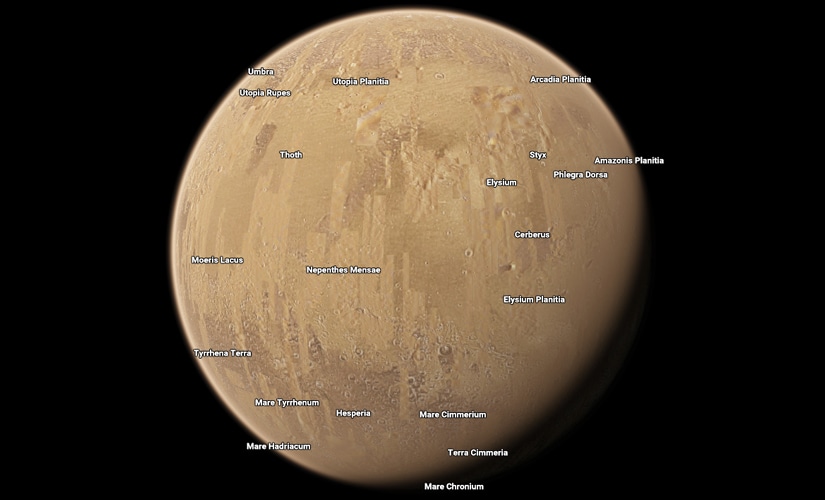 Mars. Image: Google Maps.[/caption] Next up is
Ceres
, a dwarf planet which is the largest object in the asteroid belt between Mars and Jupiter. The images used in the map are probably sourced from the observations of
NASA’s Dawn spacecraft
, which is the only orbiter to have visited the dwarf planet. Users can hunt for the
bright spots
in craters, or mysterious triangular mountains that some suspected to be
pyramids built by aliens
. The infamous bright spots can be found in the large and easy to spot Occator crater, including sharp shadows along the rim where the walls rise almost two kilometers vertically. [caption id=“attachment_4154313” align=“alignnone” width=“825”]
Mars. Image: Google Maps.[/caption] Next up is
Ceres
, a dwarf planet which is the largest object in the asteroid belt between Mars and Jupiter. The images used in the map are probably sourced from the observations of
NASA’s Dawn spacecraft
, which is the only orbiter to have visited the dwarf planet. Users can hunt for the
bright spots
in craters, or mysterious triangular mountains that some suspected to be
pyramids built by aliens
. The infamous bright spots can be found in the large and easy to spot Occator crater, including sharp shadows along the rim where the walls rise almost two kilometers vertically. [caption id=“attachment_4154313” align=“alignnone” width=“825”]
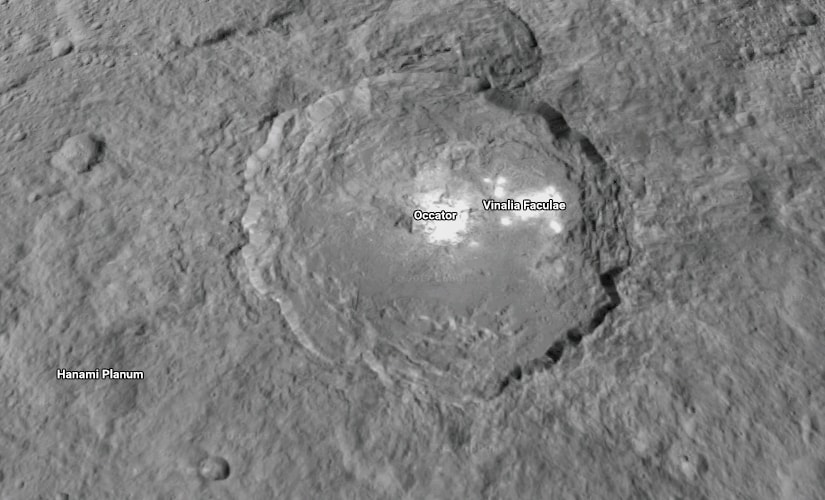 The Occator crater on Ceres. Image: NASA.[/caption] Next up are the Jovian and Saturnian moons, although the gas giants themselves have not been added. Pioneer, Voyager, Galileo, New Horizons and Juno have observed Jupiter and its surroundings, while Saturn and its moons were observed in depth by the
Cassini mission
. Google has indicated that thousands of images captured by Cassini over fourteen years were stitched together to create the maps of the Saturnian moons. The moons of Jupiter available in Google Maps are Io, Europa and Ganymede. The Saturnian moons available are Mimas, Enceladus, Dione, Rhea, Titan and Iapetus. The map of Io is most likely to be created from images gathered by the Galileo and Voyager missions. Some regions of the global map are less distinct than others. The tortured surface can be explored along with the many volcanoes, which confirmed that Io was a geologically active moon. Although the moon is slightly elongated, Io appears to be mapped on a perfect sphere. Fans of Norse mythology can find a number of features named after the Aesir, including Loki and Thor. [caption id=“attachment_4154437” align=“alignnone” width=“825”]
The Occator crater on Ceres. Image: NASA.[/caption] Next up are the Jovian and Saturnian moons, although the gas giants themselves have not been added. Pioneer, Voyager, Galileo, New Horizons and Juno have observed Jupiter and its surroundings, while Saturn and its moons were observed in depth by the
Cassini mission
. Google has indicated that thousands of images captured by Cassini over fourteen years were stitched together to create the maps of the Saturnian moons. The moons of Jupiter available in Google Maps are Io, Europa and Ganymede. The Saturnian moons available are Mimas, Enceladus, Dione, Rhea, Titan and Iapetus. The map of Io is most likely to be created from images gathered by the Galileo and Voyager missions. Some regions of the global map are less distinct than others. The tortured surface can be explored along with the many volcanoes, which confirmed that Io was a geologically active moon. Although the moon is slightly elongated, Io appears to be mapped on a perfect sphere. Fans of Norse mythology can find a number of features named after the Aesir, including Loki and Thor. [caption id=“attachment_4154437” align=“alignnone” width=“825”]
 Io. Image: Google Maps.[/caption] Europa is another exciting addition to the list, and a potential candidate for future deep space missions because of the easy availability of water. One of the biggest announcements by NASA last year was the Hubble Space Telescope imaging what appeared to be
plumes of water erupting from Europa
, confirming the existence of a global subsurface ocean. Europa is one of the icy worlds that are candidates for harbouring extraterrestrial life, and NASA is contemplating sending
autonomous underwater drones
to study the world. Unfortunately, some parts of the Europan surface are very blurred. Users can check out some of the named Linea on Europa, cracks in the ice that appear as dark striations, and are the most noticeable features on the surface. [caption id=“attachment_4154537” align=“alignnone” width=“825”]
Io. Image: Google Maps.[/caption] Europa is another exciting addition to the list, and a potential candidate for future deep space missions because of the easy availability of water. One of the biggest announcements by NASA last year was the Hubble Space Telescope imaging what appeared to be
plumes of water erupting from Europa
, confirming the existence of a global subsurface ocean. Europa is one of the icy worlds that are candidates for harbouring extraterrestrial life, and NASA is contemplating sending
autonomous underwater drones
to study the world. Unfortunately, some parts of the Europan surface are very blurred. Users can check out some of the named Linea on Europa, cracks in the ice that appear as dark striations, and are the most noticeable features on the surface. [caption id=“attachment_4154537” align=“alignnone” width=“825”]
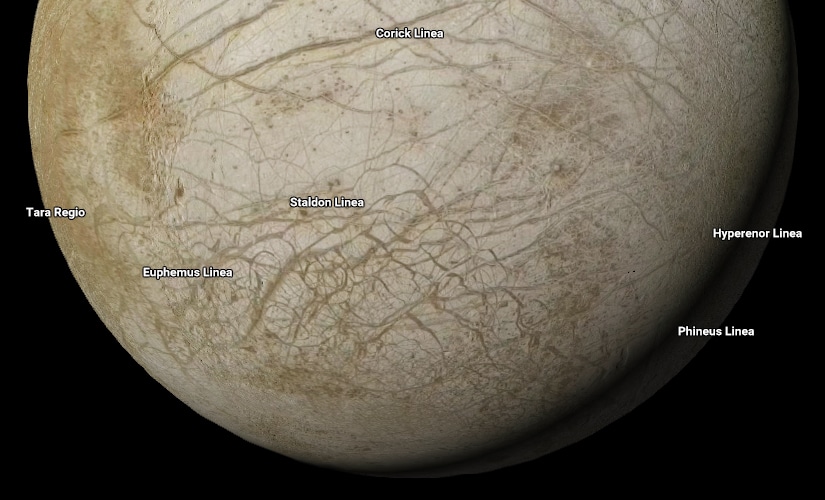 Europa. Image: Google Maps.[/caption] Ganymede is another Jovian moon with a global subsurface ocean, and as such is an object of interest when it comes to the search for
alien life on oceans other than the Earth
. In fact, Ganymede is believed to have a
saltwater ocean
, similar to the oceans on Earth. Callisto, another moon of Jupiter with a subsurface ocean, has unfortunately not made it to Google Maps. Ganymede is among the brightest moons in the solar system, and Google Maps reflects this aspect. The moon is clearly divided into darker and lighter regions, with the darker areas being older than the lighter ones. One of the most noticeable features is the massive Tashmetum ray crater named after an Akkadian goddess. [caption id=“attachment_4154587” align=“alignnone” width=“825”]
Europa. Image: Google Maps.[/caption] Ganymede is another Jovian moon with a global subsurface ocean, and as such is an object of interest when it comes to the search for
alien life on oceans other than the Earth
. In fact, Ganymede is believed to have a
saltwater ocean
, similar to the oceans on Earth. Callisto, another moon of Jupiter with a subsurface ocean, has unfortunately not made it to Google Maps. Ganymede is among the brightest moons in the solar system, and Google Maps reflects this aspect. The moon is clearly divided into darker and lighter regions, with the darker areas being older than the lighter ones. One of the most noticeable features is the massive Tashmetum ray crater named after an Akkadian goddess. [caption id=“attachment_4154587” align=“alignnone” width=“825”]
 Ganymede. Image: Google Maps.[/caption] Mimas is a Saturnian moon and Google Maps has a rather low resolution version for this world. Mimas has a pockmarked surface due to the many, many craters. Many features on the moon are named after characters from Arthurian legends. Arthur, Merlin, Uther, Gawain, Galahad, Balin, Bedivere and Modred are all Mimantean craters, while Avalon is a Chasma. The largest crater on Mimas, and the largest crater relative to the parent body in the solar system, the Herschel crater can be clearly seen. Mimas is called the “Death Star Moon” because the Herschel crater makes it appear similar to the planet-destroying weapon from Star Wars. [caption id=“attachment_4154615” align=“alignnone” width=“825”]
Ganymede. Image: Google Maps.[/caption] Mimas is a Saturnian moon and Google Maps has a rather low resolution version for this world. Mimas has a pockmarked surface due to the many, many craters. Many features on the moon are named after characters from Arthurian legends. Arthur, Merlin, Uther, Gawain, Galahad, Balin, Bedivere and Modred are all Mimantean craters, while Avalon is a Chasma. The largest crater on Mimas, and the largest crater relative to the parent body in the solar system, the Herschel crater can be clearly seen. Mimas is called the “Death Star Moon” because the Herschel crater makes it appear similar to the planet-destroying weapon from Star Wars. [caption id=“attachment_4154615” align=“alignnone” width=“825”]
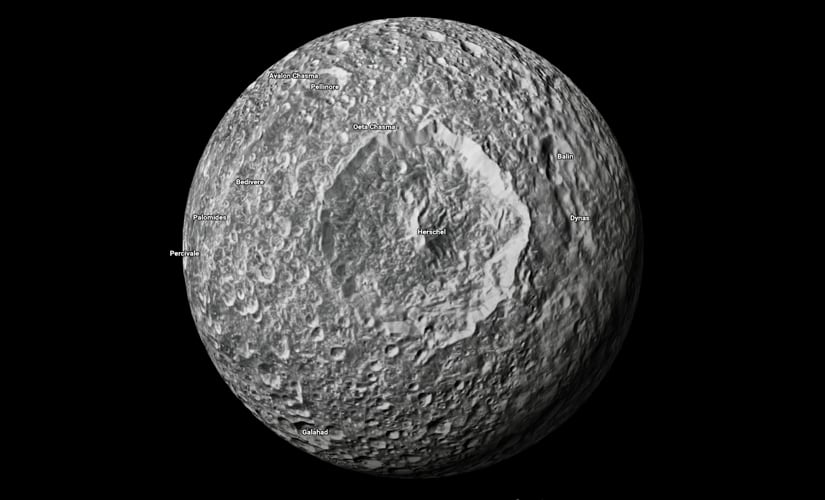 Mimas. Image: Google Maps.[/caption] Enceladus is another prime candidate for harbouring life, especially considering that almost all the ingredients necessary to support life as we know it on Earth
are also available on Enceladus
.
Jets of water erupt
from one of the most prominent features near the south pole of Enceladus, known as the tiger stripes. The tiger stripes are furrows with individual names, such as Damscus, Cairo and Alexandria. The features on Enceladus are named after characters and places in middle eastern and Arabic folk tales from the Arabian Nights. One of the interesting things to check out is the stark difference between the north and south poles of Enceladus. Cassini has found evidence that an ancient asteroid impact may have shifted the poles of the icy world
, before which the north and south poles were similar to each other. [caption id=“attachment_4154669” align=“alignnone” width=“825”]
Mimas. Image: Google Maps.[/caption] Enceladus is another prime candidate for harbouring life, especially considering that almost all the ingredients necessary to support life as we know it on Earth
are also available on Enceladus
.
Jets of water erupt
from one of the most prominent features near the south pole of Enceladus, known as the tiger stripes. The tiger stripes are furrows with individual names, such as Damscus, Cairo and Alexandria. The features on Enceladus are named after characters and places in middle eastern and Arabic folk tales from the Arabian Nights. One of the interesting things to check out is the stark difference between the north and south poles of Enceladus. Cassini has found evidence that an ancient asteroid impact may have shifted the poles of the icy world
, before which the north and south poles were similar to each other. [caption id=“attachment_4154669” align=“alignnone” width=“825”]
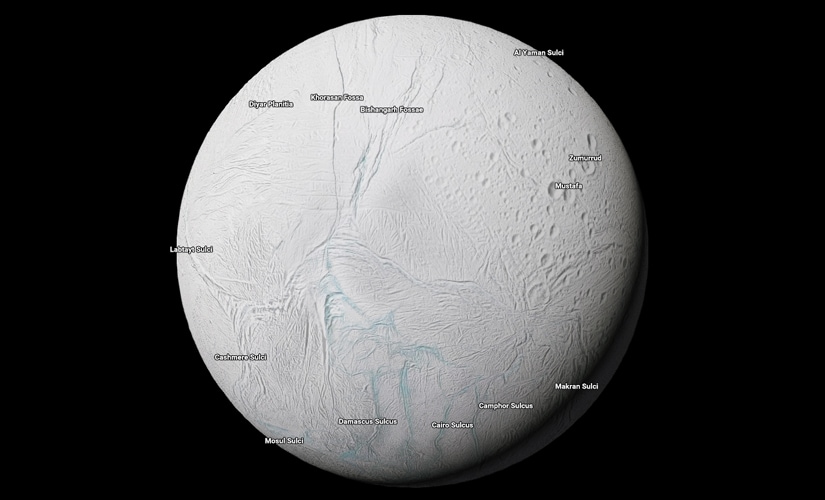 Enceladus. Image: Google.[/caption] The craters on Dione are mostly named after people and places from Greco-Roman mythology. One of the things to check out are the twin craters of Romulus and Remus, named after the legendary founders of Rome. The Latium Chasma is a prominent 360 kilometer long depression named after the promised land of the Trojans. The Chasmatas on Dione are named after people and places from Virgil’s Aenid. The surface is pockmarked by many craters, and there is a marked difference between opposite portions of the moon. While one side is dark, the other side is light. Scientists believe that Dione has a subsurface ocean as well, and Cassini has detected
traces of Oxygen
in the upper atmosphere of the moon. [caption id=“attachment_4154725” align=“alignnone” width=“825”]
Enceladus. Image: Google.[/caption] The craters on Dione are mostly named after people and places from Greco-Roman mythology. One of the things to check out are the twin craters of Romulus and Remus, named after the legendary founders of Rome. The Latium Chasma is a prominent 360 kilometer long depression named after the promised land of the Trojans. The Chasmatas on Dione are named after people and places from Virgil’s Aenid. The surface is pockmarked by many craters, and there is a marked difference between opposite portions of the moon. While one side is dark, the other side is light. Scientists believe that Dione has a subsurface ocean as well, and Cassini has detected
traces of Oxygen
in the upper atmosphere of the moon. [caption id=“attachment_4154725” align=“alignnone” width=“825”]
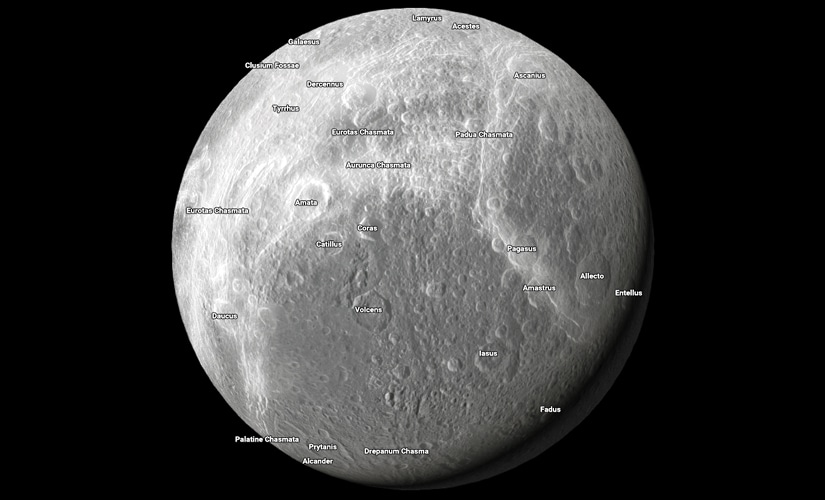 Dione. Image: Google Maps.[/caption] Rhea is a moon of Saturn with surface features similar to Dione. One side of the moon is dark and another side is light. Rhea is one of my favorite moons to explore on Google Maps, because the names of the features do not exactly follow a theme, and is named after obscure and eclectic people and places from many mythologies around the world. The surface features on Rhea are named after Eskimo, Incan, Peurto Rican, Persian, Native American, Polynesian, Korean, Ghanian, Siberian, Ukrainian, Bolivian, Yukatian and Japanese mythologies… among others. Some places are inspired by Hindu mythology as well, including the Singbonga crater named after a creator god worshiped in Jharkhand, Bihar and Orissa. [caption id=“attachment_4154777” align=“alignnone” width=“825”]
Dione. Image: Google Maps.[/caption] Rhea is a moon of Saturn with surface features similar to Dione. One side of the moon is dark and another side is light. Rhea is one of my favorite moons to explore on Google Maps, because the names of the features do not exactly follow a theme, and is named after obscure and eclectic people and places from many mythologies around the world. The surface features on Rhea are named after Eskimo, Incan, Peurto Rican, Persian, Native American, Polynesian, Korean, Ghanian, Siberian, Ukrainian, Bolivian, Yukatian and Japanese mythologies… among others. Some places are inspired by Hindu mythology as well, including the Singbonga crater named after a creator god worshiped in Jharkhand, Bihar and Orissa. [caption id=“attachment_4154777” align=“alignnone” width=“825”]
 Rhea. Google Maps.[/caption] Fans of the Tolkein Legendarium will find a number of features on Titan named after characters from the books, including Arwen, Legolas, Gandalf and Bilbo. The Misty Mountains, Mount Doom and Erebor can also be found on Titan, apart from Middle Earth. In all, there are twenty features on Titan named after people or places from the works of Tolkein. Titan played an important role in catapulting Cassini towards its final rendezvous with Saturn, in a maneuver known as the
goodbye kiss
. Cassini found the building blocks of life on Titan, and researchers believe that the vast methane seas on Titan may harbour an
exotic form of life
. The methane seas can be seen in Google Maps. [caption id=“attachment_4154851” align=“alignnone” width=“825”]
Rhea. Google Maps.[/caption] Fans of the Tolkein Legendarium will find a number of features on Titan named after characters from the books, including Arwen, Legolas, Gandalf and Bilbo. The Misty Mountains, Mount Doom and Erebor can also be found on Titan, apart from Middle Earth. In all, there are twenty features on Titan named after people or places from the works of Tolkein. Titan played an important role in catapulting Cassini towards its final rendezvous with Saturn, in a maneuver known as the
goodbye kiss
. Cassini found the building blocks of life on Titan, and researchers believe that the vast methane seas on Titan may harbour an
exotic form of life
. The methane seas can be seen in Google Maps. [caption id=“attachment_4154851” align=“alignnone” width=“825”]
 Titan. Image: Google Maps.[/caption] Iapetus is known as the Yin-Yang moon because of the distinct colouring where half the planet appears white while the other half appears black. This dichotomy can be clearly seen in 3D with Google Maps. One of the prominent features to spot is the 504-kilometer wide Engelier crater. Most of the names of the features on Iapetus are named after people and places from the epic French poem The Song of Roland. NASA made Cassini execute a close flyby of the moon in 1997, which led to the creation of a global surface map. In September 2017, after Cassini had become a shooting star in the skies of Saturn, NASA released the
final image of Iapetus
captured by Cassini. [caption id=“attachment_4154909” align=“alignnone” width=“825”]
Titan. Image: Google Maps.[/caption] Iapetus is known as the Yin-Yang moon because of the distinct colouring where half the planet appears white while the other half appears black. This dichotomy can be clearly seen in 3D with Google Maps. One of the prominent features to spot is the 504-kilometer wide Engelier crater. Most of the names of the features on Iapetus are named after people and places from the epic French poem The Song of Roland. NASA made Cassini execute a close flyby of the moon in 1997, which led to the creation of a global surface map. In September 2017, after Cassini had become a shooting star in the skies of Saturn, NASA released the
final image of Iapetus
captured by Cassini. [caption id=“attachment_4154909” align=“alignnone” width=“825”]
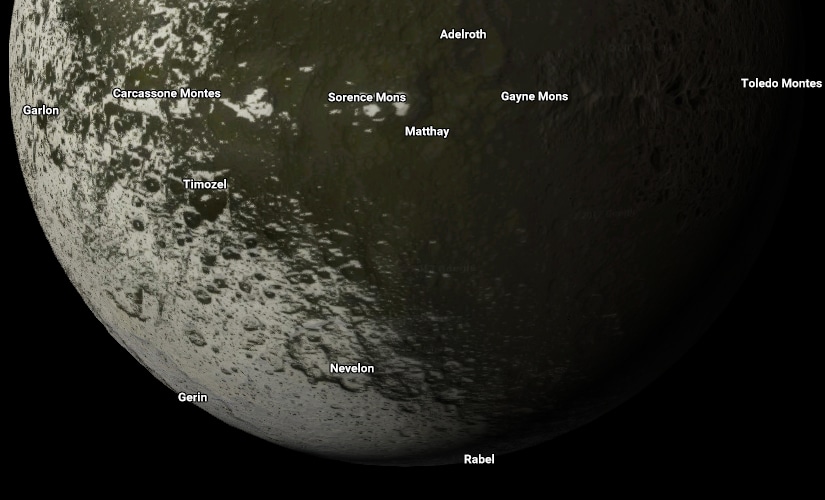 Iapetus. Image: Google Maps.[/caption] The last “dwarf planet” on the list is Pluto. The images used for the map are likely to be captured by NASA’s New Horizons mission, and about a bottom third of the dwarf planet is left blank. Readers can explore the mysterious
bladed terrain on Pluto
, which appears to be related to the geological history and complex climate, which just goes to show that
Pluto is as much a planet as any other
. In fact, planetary scientists working with the New Horizons are leading the charge to classify Pluto as a planet again
. Most of the surface features of the planet are
named after pioneers
, including geographers, adventurers, astronomers, researchers, poets and spacecraft. The Balrog Macula, a dark region named after a fire spirit from the Lord of the Rings series, can be found on Pluto. Unfortunately, Google Maps does not include Pluto’s Moon Charon, which features the even more notorious Mordor Macula. [caption id=“attachment_4154973” align=“alignnone” width=“825”]
Iapetus. Image: Google Maps.[/caption] The last “dwarf planet” on the list is Pluto. The images used for the map are likely to be captured by NASA’s New Horizons mission, and about a bottom third of the dwarf planet is left blank. Readers can explore the mysterious
bladed terrain on Pluto
, which appears to be related to the geological history and complex climate, which just goes to show that
Pluto is as much a planet as any other
. In fact, planetary scientists working with the New Horizons are leading the charge to classify Pluto as a planet again
. Most of the surface features of the planet are
named after pioneers
, including geographers, adventurers, astronomers, researchers, poets and spacecraft. The Balrog Macula, a dark region named after a fire spirit from the Lord of the Rings series, can be found on Pluto. Unfortunately, Google Maps does not include Pluto’s Moon Charon, which features the even more notorious Mordor Macula. [caption id=“attachment_4154973” align=“alignnone” width=“825”]
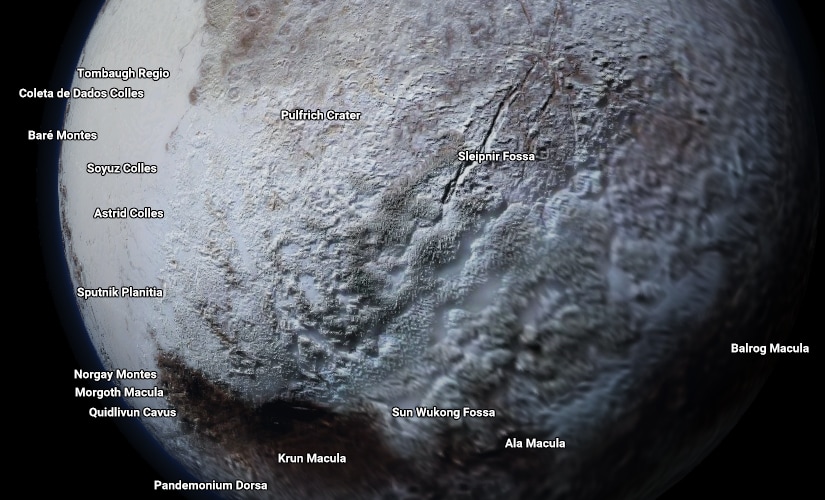 Pluto. Image: Google Maps.[/caption] Google thanked the
creator of some of the maps in a blog post
, “Special thanks goes to astronomical artist Björn Jónsson, who assembled the planetary maps of Europa, Ganymede, Rhea, and Mimas by working with imagery from NASA and the European Space Agency.”
Pluto. Image: Google Maps.[/caption] Google thanked the
creator of some of the maps in a blog post
, “Special thanks goes to astronomical artist Björn Jónsson, who assembled the planetary maps of Europa, Ganymede, Rhea, and Mimas by working with imagery from NASA and the European Space Agency.”
Google Maps now lets you explore other planets and moons in the solar system
Aditya Madanapalle
• October 18, 2017, 21:27:56 IST
The maps were created by putting together multiple photographs, and the level of detail is not the same as maps of the Earth.
Advertisement
)
End of Article